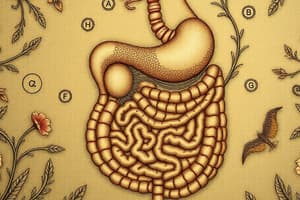Podcast
Questions and Answers
What is chemical digestion and absorption of the major nutrients?
What is chemical digestion and absorption of the major nutrients?
What are digestible dietary carbohydrates primarily made of?
What are digestible dietary carbohydrates primarily made of?
Mostly starch
What are the steps in starch digestion?
What are the steps in starch digestion?
Starch → Oligosaccharides → Maltose → Glucose → Absorbed by small intestine
Where does starch digestion begin?
Where does starch digestion begin?
What enzyme catalyzes the hydrolysis of starch?
What enzyme catalyzes the hydrolysis of starch?
What is the optimal pH for salivary amylase?
What is the optimal pH for salivary amylase?
Salivary amylase is denatured by stomach acid.
Salivary amylase is denatured by stomach acid.
When does starch digestion continue?
When does starch digestion continue?
When is digestion completed?
When is digestion completed?
What are the two major dietary disaccharides?
What are the two major dietary disaccharides?
What is absorbed with 80% being glucose in the intestinal epithelium?
What is absorbed with 80% being glucose in the intestinal epithelium?
By what process is fructose absorbed?
By what process is fructose absorbed?
Name one source of amino acids.
Name one source of amino acids.
What is the optimal pH for pepsin?
What is the optimal pH for pepsin?
Final digestion of proteins in the small intestine is performed by which enzymes?
Final digestion of proteins in the small intestine is performed by which enzymes?
Digestion of protein begins in the stomach.
Digestion of protein begins in the stomach.
What are the two digestive enzymes contributed by saliva?
What are the two digestive enzymes contributed by saliva?
Most lipid digestion occurs within the small intestine due to pancreatic lipase.
Most lipid digestion occurs within the small intestine due to pancreatic lipase.
Lipids are hydrophobic and tend to form globules.
Lipids are hydrophobic and tend to form globules.
Leafy vegetables are the most important source of calcium in the human diet.
Leafy vegetables are the most important source of calcium in the human diet.
Study Notes
Chemical Digestion and Absorption
- Major nutrients undergo chemical digestion and absorption, primarily in the small intestine.
- Digestible dietary carbohydrates are mainly starch; glycogen is also digestible but in negligible amounts.
- Cellulose serves as dietary fiber and is indigestible in humans but digested in ruminants.
Starch Digestion
- Begins in the mouth, with approximately 50% digested before reaching the small intestine.
- Process: Starch → Oligosaccharides → Maltose → Glucose, absorbed by the small intestine.
- Salivary amylase initiates hydrolysis of starch into oligosaccharides, functioning optimally at pH 6.8-7.0.
Salivary Amylase
- Denatured by stomach acid; can still work for 1-2 hours if protected in the food mass.
- Starch digestion in the small intestine continues with pancreatic amylase; conversion to oligosaccharides and maltose occurs in about 10 minutes.
Digestion of Disaccharides
- Main dietary disaccharides: Sucrose (digested by sucrase) and Lactose (digested by lactase); maltose is also present.
Monosaccharide Absorption
- Glucose, galactose, and fructose are absorbed in different ways:
- Glucose (~80%) and galactose via sodium-glucose transporter (SGLT).
- Fructose via facilitated diffusion, mostly converted to glucose.
- All monosaccharides enter the capillaries of the villus, entering the portal system to the liver.
Protein Digestion
- Three sources of amino acids: dietary proteins (44-60g/day), digestive enzymes, and sloughed epithelial cells (around 30g/day).
- Begins in the stomach with pepsin (optimal pH 1.5-3.5), inactive upon entering the duodenum.
- In the small intestine, pancreatic enzymes (trypsin and chymotrypsin) hydrolyze polypeptides into shorter oligopeptides, with final digestion by carboxypeptidase, aminopeptidase, and dipeptidase.
Amino Acid Absorption
- Enterocytes utilize sodium-dependent amino acid cotransporters for absorption.
- Some dipeptides and tripeptides are absorbed but hydrolyzed into amino acids before exiting.
Lipid Digestion
- Begins with lingual lipase from tongue; pancreatic lipase carries out most fat digestion in the small intestine.
- Emulsification by bile increases enzyme exposure to fat molecules.
Absorption of Lipids
- Lipids are hydrophobic, supported by micelles formed from bile acids.
- Micelles transport fat-soluble vitamins, cholesterol, fatty acids, and monoglycerides to enterocytes.
Processing Within Enterocytes
- Fatty acids and monoglycerides resynthesized into triglycerides in the smooth ER, packaged as chylomicrons for transport via lacteals into lymphatic circulation.
Nucleic Acids and Vitamins
- Nucleic acids hydrolyzed to nucleotides, then decomposed into phosphate ions, sugars, and bases for absorption.
- Fat-soluble vitamins A, D, E, K absorbed with lipids; water-soluble vitamins absorbed via simple diffusion, except vitamin B12 which requires intrinsic factor.
Minerals and Water Absorption
- Minerals absorbed throughout the small intestine; absorption rates vary based on body needs.
- Calcium is primarily sourced from dairy, while excessive oxalate in leafy vegetables hinders absorption.
- Water absorption is crucial; diarrhea and constipation occur when absorption is too low or too high, respectively.
Studying That Suits You
Use AI to generate personalized quizzes and flashcards to suit your learning preferences.
Description
Explore the intricate processes of chemical digestion and nutrient absorption in the human body, primarily occurring in the small intestine. This quiz delves into starch digestion, the role of salivary amylase, and the digestion of disaccharides. Test your understanding of how major nutrients are processed and absorbed.




